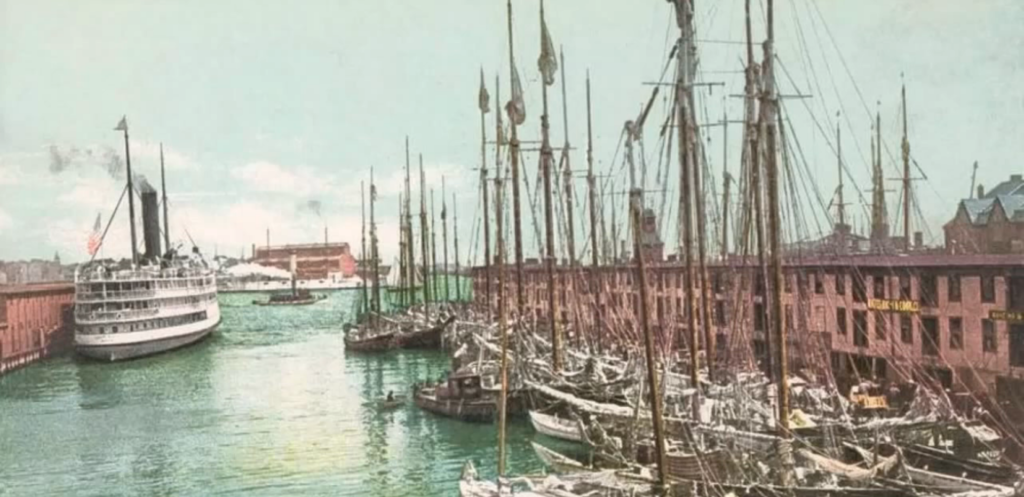
Credits to Bravura Media Company
Boston in the 1800s was a city in transition, undergoing significant social, economic, and political changes that would shape its future. During this period, Boston emerged as a center of commerce, education, and culture, and it played a leading role in the country’s political and social developments. In this article, we will explore what Boston was like in the 1800s, focusing on its economy, culture, politics, and social issues.
Economy
Boston’s economy in the 1800s was driven by its position as a major port city, as well as its growing manufacturing industry. The city’s port was a hub of trade, and it played a critical role in the transatlantic slave trade, which brought enslaved Africans to the United States. By the early 1800s, however, Boston had become a center of abolitionist activity, and many Bostonians were actively involved in the movement to end slavery.
In addition to its role in the slave trade, Boston’s port was also an important center of commerce, with ships bringing goods from around the world to the city’s bustling waterfront. The city’s manufacturing industry also grew rapidly in the 1800s, with factories producing textiles, shoes, and machinery. This growth was fueled by technological innovations, such as the development of the power loom, which allowed textile manufacturers to produce cloth more quickly and efficiently.
Culture
Boston in the 1800s was a city known for its intellectual and cultural life. The city was home to many of the country’s leading thinkers, writers, and artists, and it played a significant role in the development of American literature and culture. Some of the most famous writers of the time, including Ralph Waldo Emerson, Henry David Thoreau, and Nathaniel Hawthorne, were part of a literary movement known as transcendentalism, which emphasized the importance of individualism and self-reliance.
In addition to its literary scene, Boston was also a center of art and music, with many concerts and exhibitions taking place in the city’s theaters and museums. The Boston Symphony Orchestra was founded in 1881, and the Museum of Fine Arts, which opened in 1876, became one of the country’s leading art museums.
Politics
Boston in the 1800s was a city marked by political activism and social reform. The city was home to a number of political and social movements, including the abolitionist and temperance movements, which sought to end slavery and curb alcohol consumption, respectively. Boston was also a center of women’s rights activism, with many Bostonians advocating for women’s suffrage and equal rights.
The city’s political scene was dominated by the Democratic Party, which had a strong base of support among the city’s working-class residents. However, Boston also had a strong Republican Party presence, with many of the city’s wealthiest residents supporting the party.
Social Issues
Boston in the 1800s was a city marked by significant social issues and challenges. One of the most pressing of these was the issue of immigration, as waves of immigrants from Europe, particularly Ireland, began to arrive in the city in large numbers. Many of these immigrants were poor and lacked the resources to support themselves, leading to overcrowding, poor living conditions, and high rates of disease.
Boston was also marked by significant racial tensions, particularly between African Americans and white residents. Slavery had been abolished in Massachusetts in 1783, but racial discrimination and inequality persisted in the city. African American residents faced significant barriers to employment and education, and they were often excluded from the city’s cultural and political life.
Finally, Boston was also marked by significant economic inequality, with the city’s wealthiest residents living in luxury while many of its working-class residents struggled to make ends meet. This inequality was reflected in the city’s architecture, with grand mansions and estates lining Commonwealth Avenue and Beacon Hill, while tenement housing and overcrowded apartment buildings dominated the city’s working-class neighborhoods.
Despite these challenges, Boston in the 1800s was a city in transition, undergoing significant changes that would shape its future. The city’s growing economy, intellectual and cultural life, and political and social activism would lay the groundwork for Boston’s emergence as a major American city in the 20th century. Many of the issues and challenges that Boston faced in the 1800s, including immigration, racial inequality, and economic inequality, continue to be relevant to the city today, and they serve as a reminder of the city’s complex and multifaceted history.
There are several places in Boston where visitors can step back in time and experience what life was like in the 1800s. Here are some of the best places to visit:
- The USS Constitution Museum: The USS Constitution Museum, located in the Charlestown Navy Yard, is a museum dedicated to the history of the USS Constitution, one of the oldest commissioned ships in the United States Navy. Visitors can explore the museum’s exhibits and artifacts and learn about life at sea during the 1800s.
- The Gibson House Museum: The Gibson House Museum, located in Boston’s Back Bay neighborhood, is a historic house museum that showcases life in the 19th century. Visitors can explore the house and its period furnishings and learn about the daily lives of the Gibson family and their servants.
- The Boston Tea Party Ships and Museum: The Boston Tea Party Ships and Museum is an interactive museum that provides a unique look into the events leading up to the Boston Tea Party. Visitors can participate in reenactments and demonstrations, explore the museum’s exhibits and artifacts, and learn about the people and events that shaped Boston’s history.
There is also Freedom Trail, Paul Revere House and more! Boston is a city rich in history and culture, and there are many places where visitors can step back in time and experience what life was like in the 1800s. From historic sites and museums to preserved homes and neighborhoods, Boston offers a wealth of opportunities to explore its past and learn about the events and people that have shaped its future.